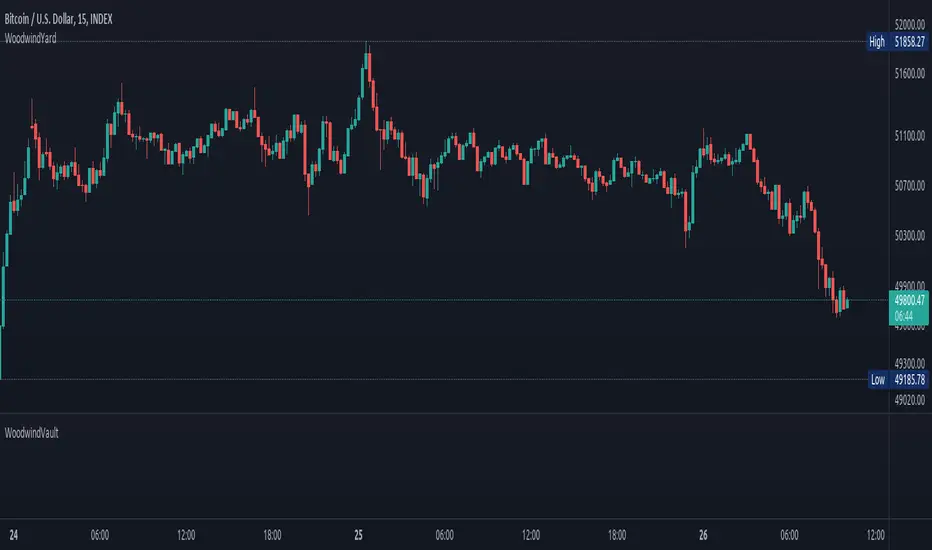PINE LIBRARY
업데이트됨 Woodwind Vault

Library "WoodwindVault"
Woodwind Vault provides reusable functions to support Thange Woodwind Playbook execution.
getHighestHighAndLowestLow(period) determines the highest-high and lowest-low for the specified time interval.
Parameters:
period: int, the time interval for finding the highest-high and lowest-low.
Returns: float, the highest-high and lowest-low of the candles in the specified period.
findEquilibrium() projects a one glance view of the entire resistance net faced by the price. It does so by computing different equilibrium points for the price.
Returns: longTermEquilibriumB float, the midpoint of highest-high and lowest-low of the candles in last longTermPeriod.
getGlance(fast, slow) glances over the 2 equilibrium points from moving averages and establishes whether its bullish or bearish.
Parameters:
fast: float, the fast moving point.
slow: float, the slow moving point.
Returns: string, it is "bullish" if fast moving point is over the slow moving point o/w returns "bearish".
positionRelativeToLevel(point, level) determines first point's position w.r.t a specified level.
Parameters:
point: float, the first point (typically a fast moving average).
level: float, the second point acting as a level (typically a slow moving average).
Returns: string, the above/below/at position w.r.t level.
positionRelativeToRange(point, fromLevel, toLevel) determines first point's position w.r.t a range (typically a resistance band).
Parameters:
point: float, the first point.
fromLevel: float, the from-range which is typically a fast moving line.
toLevel: float, the to-range which is typically a slow moving line.
Returns: string, the above/below/within range.
Woodwind Vault provides reusable functions to support Thange Woodwind Playbook execution.
getHighestHighAndLowestLow(period) determines the highest-high and lowest-low for the specified time interval.
Parameters:
period: int, the time interval for finding the highest-high and lowest-low.
Returns: float, the highest-high and lowest-low of the candles in the specified period.
findEquilibrium() projects a one glance view of the entire resistance net faced by the price. It does so by computing different equilibrium points for the price.
Returns: longTermEquilibriumB float, the midpoint of highest-high and lowest-low of the candles in last longTermPeriod.
getGlance(fast, slow) glances over the 2 equilibrium points from moving averages and establishes whether its bullish or bearish.
Parameters:
fast: float, the fast moving point.
slow: float, the slow moving point.
Returns: string, it is "bullish" if fast moving point is over the slow moving point o/w returns "bearish".
positionRelativeToLevel(point, level) determines first point's position w.r.t a specified level.
Parameters:
point: float, the first point (typically a fast moving average).
level: float, the second point acting as a level (typically a slow moving average).
Returns: string, the above/below/at position w.r.t level.
positionRelativeToRange(point, fromLevel, toLevel) determines first point's position w.r.t a range (typically a resistance band).
Parameters:
point: float, the first point.
fromLevel: float, the from-range which is typically a fast moving line.
toLevel: float, the to-range which is typically a slow moving line.
Returns: string, the above/below/within range.
릴리즈 노트
v2릴리즈 노트
v3Added:
getEquilibriumPeriods(scheme) gets a suitable combination of equilibrium periods for the specified scheme.
Parameters:
scheme: string, the name of the scheme.
Returns: 4 float values, a best suited combination of equilibrium periods.
computeExitGains(entry, exit, qty, remainingQty, direction) calculates the gains after a position is scaled down.
Parameters:
entry: float, the entry price of the short/long position.
exit: float, the exit price of the short/long position.
qty: float, the quantity by which a position is to be scaled down.
remainingQty: float, the remaining quantity before the scale down.
direction: int, its -1 for a short position and +1 for a long position.
Returns: _gains float, the profit & loss after the scale down.
Updated:
positionRelativeToRange(point, fromLevel, toLevel) determines the placement of price w.r.t a range (i.e. a dynamic resistance band).
Parameters:
point: float, the price.
fromLevel: float, the from-range which is typically a fast moving line.
toLevel: float, the to-range which is typically a slow moving line.
Returns: string, the above/below/within range.
릴리즈 노트
v4Removed:
getHighestHighAndLowestLow(period) determines the highest-high and the lowest-low value for the specified interval.
getEquilibriumPeriods(scheme) gets a suitable combination of equilibrium periods for the specified scheme.
findEquilibrium() projects a one glance view of the entire resistance net faced by the price. It does so by computing different equilibrium points for the price.
getGlance(fast, slow) glances over the 2 equilibrium points from moving averages and establishes whether its bullish or bearish.
positionRelativeToLevel(point, level) determines the placement of price w.r.t the specified resistance/support level.
positionRelativeToRange(point, fromLevel, toLevel) determines the placement of price w.r.t a range (i.e. a dynamic resistance band).
파인 라이브러리
트레이딩뷰의 진정한 정신에 따라, 작성자는 이 파인 코드를 오픈소스 라이브러리로 게시하여 커뮤니티의 다른 파인 프로그래머들이 재사용할 수 있도록 했습니다. 작성자에게 경의를 표합니다! 이 라이브러리는 개인적으로 사용하거나 다른 오픈소스 게시물에서 사용할 수 있지만, 이 코드의 게시물 내 재사용은 하우스 룰에 따라 규제됩니다.
면책사항
해당 정보와 게시물은 금융, 투자, 트레이딩 또는 기타 유형의 조언이나 권장 사항으로 간주되지 않으며, 트레이딩뷰에서 제공하거나 보증하는 것이 아닙니다. 자세한 내용은 이용 약관을 참조하세요.
파인 라이브러리
트레이딩뷰의 진정한 정신에 따라, 작성자는 이 파인 코드를 오픈소스 라이브러리로 게시하여 커뮤니티의 다른 파인 프로그래머들이 재사용할 수 있도록 했습니다. 작성자에게 경의를 표합니다! 이 라이브러리는 개인적으로 사용하거나 다른 오픈소스 게시물에서 사용할 수 있지만, 이 코드의 게시물 내 재사용은 하우스 룰에 따라 규제됩니다.
면책사항
해당 정보와 게시물은 금융, 투자, 트레이딩 또는 기타 유형의 조언이나 권장 사항으로 간주되지 않으며, 트레이딩뷰에서 제공하거나 보증하는 것이 아닙니다. 자세한 내용은 이용 약관을 참조하세요.